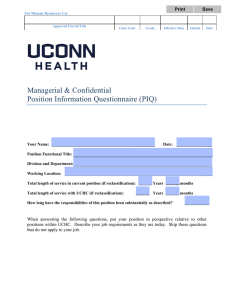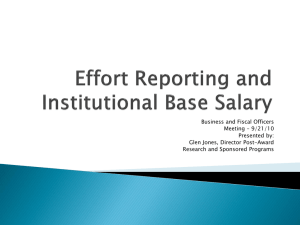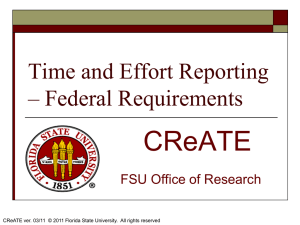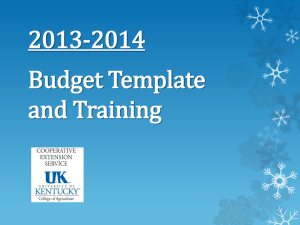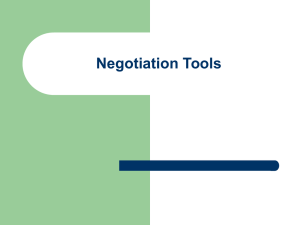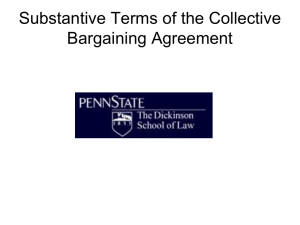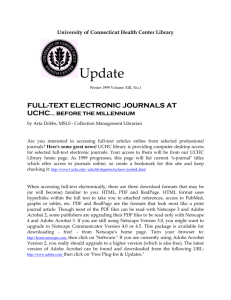Effort Reporting Training Module
advertisement
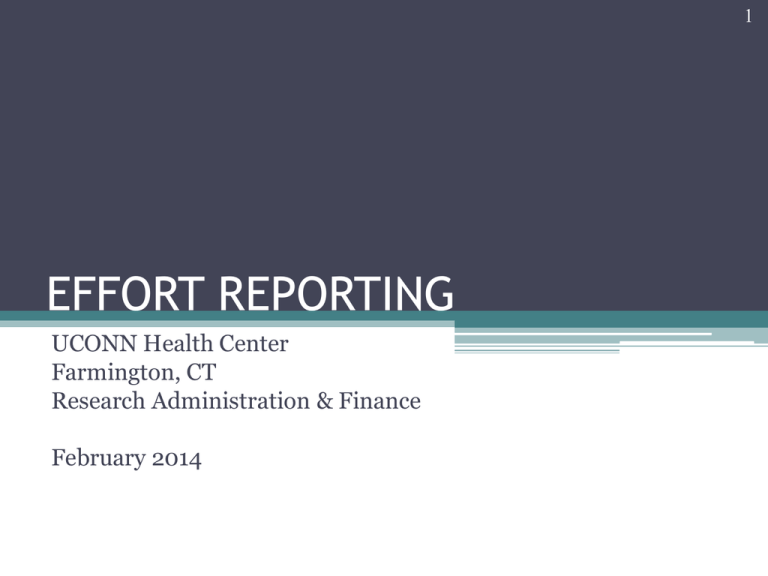
1 EFFORT REPORTING UCONN Health Center Farmington, CT Research Administration & Finance February 2014 2 What is Effort Reporting? • A retrospective assurance that the time committed and/or budgeted corresponds to the time spent and effort invested on a given sponsored project for a specific period. 3 Why do we certify effort? • Employees paid in whole or part from extramurally-funded sources required to certify to effort/$$ expended on these projects as a condition of accepting the funding. • UCHC obligated to provide the administrative support and system to facilitate effort reporting. • Required…obligated… 4 By whom? • As a condition of accepting federal funds, we (institutionally and individually) agree to meet federal guidelines for determining costs applicable to Grants (OMB Circular A-21). • Other sponsors, including the State of Connecticut. • The University. 5 What is the standard? • The Federal government is the established standard. More than 75% of UCHC’s research $$ are from federal agencies, predominantly the National Institutes of Health (NIH). • Federal government accepts ambiguity in research: ▫ “In the use of any methods for apportioning salaries, it is recognized that, in an academic setting, teaching, research, service, and administration are often inextricably intermingled. A precise assessment of factors that contribute to costs is not always feasible, nor is it expected. Reliance, therefore, is placed on estimates in which a degree of tolerance is appropriate.” OMB Cir A-21, Section J10b(1)(c) • But institutional policies and procedures are required. 6 What Criteria is Expected by the Federal Government to Meet the Standard? • OMB Circular A-21, Section J.10.b(2) ▫ A system of allocating salaries based on effort that is incorporated into the official records of the institution. ▫ Must reasonably reflect the activity of the employee. ▫ May be made initially on the basis of estimates, but significant changes must be identified and entered into the payroll distribution system. ▫ An after-the-fact confirmation by a “responsible person with suitable means of verification that the work was performed.” 7 Mistake or Fraud? The Federal Government has the power to impose sanctions on you and the institution for actions “deemed” to be fraudulent. These sanctions, and other actions, include… • Cost disallowances and fines if effort reported does not appear reasonable. • Special monitoring. • Name in the news. • Fraud violations may subject both institution and individual to civil and criminal prosecution. 8 The Bottom Line • Recent civil settlements between other research institutions and the Federal Government: Yale - $7.60 million Northwestern - $5.50 million Johns Hopkins - $2.60 million (for 1 PI) East Carolina University - $2.60 million Harvard/Beth Israel Deaconess MC - $3.25 million 9 The Bottom Line continued UCHC’s policies and procedures exist to guide and protect researchers and the institution. Recent effort reporting audits have sited UCHC for the following: • UCHC A-133 audit findings: ▫ 2008 Effort reports not certified on a timely basis become questioned costs and therefore material findings. ▫ 2008 Particularly successful PI had 99% effort approved to research. ▫ 2007 PI shares password. ▫ 2007 Labor distribution change authorization (LDCA) are requested after effort has been certified – what is the basis for the certification in the first place? 10 Red Flags What types of activities cause concern for UCHC and how do we mitigate them? • Significant number of re-certifications – Pro-actively manage effort. • More than 95% effort on sponsored accounts – review effort commitments with Chair and AVP Research Administration & Finance on semi-annual basis. • Non-organized research sponsored accounts with 0% effort (clinical trials) – what’s the justification, does it make sense? • NIH salary cap violations – track salary cap investigators and review direct charges to grants. • 1st hand knowledge test – did the investigator have 1st hand knowledge? If not, who did? • Accounts where effort is promised but none delivered. 11 Red Flags (continued) • Late or missing effort reports – will result in suspension of spending privileges. • Data inconsistency between financial and effort reporting data and other sources of effort data: ▫ Time allocated to non-research activities Teaching/Clinic Committees/NIH Study Sections Chair responsibilities ▫ Payroll records ▫ Tenure material ▫ NIH Biographical Sketches and JIT Other Support pages ▫ Progress Reports 12 The Details 1. 2. 3. 4. 5. 6. Who must file effort reports? What is effort and how is it determined? What is Cost Share? What is Salary Cap Cost Share? What about changes to effort? What do I do when a grant goes into a “No Cost Extension?” 7. What is our process for reporting effort? 13 1. Who must file Effort Reports? • Faculty who receive salary support from a sponsored project and/or have committed effort on a sponsored project. • Staff who receive salary support from a sponsored project or who devoted effort to a grant as cost sharing (limited by UCHC policy #2002-14). Staff effort reports are filed by the PI. 14 2. What is effort and how is it determined? • Time devoted to all institutional activities expressed as a % of total institutional activities. • Total institutional activities includes time spent on: ▫ ▫ ▫ ▫ ▫ Patient care Research Chair and committee responsibilities NIH study sections Education • Institutional activities do not include external professional activities for which you receive remuneration. • Effort is NOT a 40-hour work week. It is how you allocate your time across ALL your faculty activities. 15 3. What is Cost Share? • Cost share is that portion of an employee’s effort or salary that is paid by the institution, rather than the sponsor. • Cost sharing of effort can be mandatory (required by the sponsor) or voluntary. • Cost sharing of salary as a result of the sponsor limiting the salary chargeable to a grant is salary cap cost share. • See policy #2002-14. 16 3a. Effort Cost Sharing • UCHC only recognizes “committed effort” cost sharing. ▫ Committed effort cost share is a binding commitment between UCHC, the employee, and sponsor. ▫ UCHC requires prior approval for cost share before proposal submitted. ▫ Cost sharing is limited to PI and key personnel. ▫ Committed cost share can be mandatory (required by the sponsor) or voluntary. ▫ Voluntary committed cost share becomes mandatory when approved/awarded by the sponsor. • See policy #2002-14. 17 4. Salary Cap Cost Sharing • Certain sponsors, including the National Institutes of Health, limit the amount of salary that can be direct charged to a grant. ▫ 2014 salary cap at Executive Level II = $181,500 ▫ Proportional amounts over this cap must be reported as Salary Cap Cost Share. An employee making $200,000 and committed 50% to a grant would have a salary cap cost share amount of $9,250. (200,000 * .5)-(181,500 * .5) = $9,250 ▫ Salary Cap Cost Share does not impact effort. It is a transfer of salary $$ only from the sponsored account to the cost share account. ▫ With the current version effort reporting, Research Finance tracks salary cap cost share and transfers dollars, leaving the effort report intact for certifying effort. 18 5. What do I do when my effort changes? • • • • ▫ ▫ Effort on a sponsored account should match the commitment as proposed in the grant proposal or amended with the sponsor. Changes to effort should be made according to the terms of the award. Federal requirements require prior notification for reductions of effort amounting to 25% or greater. Prospective changes: Use the EPAF process to change future allocation of effort. Retrospective changes: Use Labor Distribution Change Authorization (LDCA) process to change posted payroll charges. Allowable retrospective changes include: Changes to the current effort reporting period or older periods when effort has not yet been certified. Changes to certified effort only permitted with Research Finance approval. 19 6. What happens to effort during a “No-Cost-Extension” • A no-cost-extension is considered an extension of the project as approved. • PI effort must continue to be direct charged to the grant or cost-shared as previously approved. • Effort can be reduced by following the process defined previously. 20 7. What is UCHC’s effort reporting process? • UCHC’s Effort Reporting System (ERS), was designed and developed by UCHC to meet the reporting needs of our research community. • ERS is available on-line from any computer (Mac or PC) with internet access and a commonly used web-browser, such as Internet Explorer or Firefox. 21 ERS Access • ERS link: http://efforttracker.cam.uchc.edu/ • Step-by-step instructions on completing the review and approval or certification of effort can be found under the Help menu or by following this link: http://efforttracker.cam.uchc.edu/documents/ETS_Effort_Reporting.pdf
